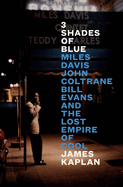
Hepcats, rejoice: fans of jazz and its mid-20th-century evolution who are looking for a history that's the cat's meow (for nonenthusiasts, that means excellent) will want to snap up a copy of 3 Shades of Blue by James Kaplan (Irving Berlin). Kaplan devotes this appreciation to jazz created from 1942 to 1967, music he calls "[n]ot antique, not anodyne, not forbiddingly difficult, and viscerally thrilling." Center stage are three indisputable giants: Miles Davis, who grew up in privilege and developed "a sound as singular and instantly identifiable as his speaking voice"; John Coltrane, the saxophonist whose A Love Supreme Kaplan calls "a work of transcendent beauty and serenity"; and Bill Evans, who went from "a faint, pulsing blip on the national jazz radar" to international recognition as one of the most innovative pianists in history.
Other luminaries also get attention in this lively work, mainly Charlie Parker, Dizzy Gillespie, and Thelonious Monk. Kaplan covers the highlights, and lowlights, of that era: the innovations in bebop, modal jazz, and free jazz; the landmark recordings of 1959, including Miles's Kind of Blue and Ornette Coleman's The Shape of Jazz to Come; the racism Black performers endured; and the consequences of rampant heroin use. Kaplan overdoes the genius talk, but the book has many moments fans will savor, as when the saxophonist Cannonball Adderley falls asleep during a recording session and Miles chastises him with, "Don't snore on my solo, bitch." Fortunately, there's nothing soporific about this groovy book. --Michael Magras, freelance book reviewer

